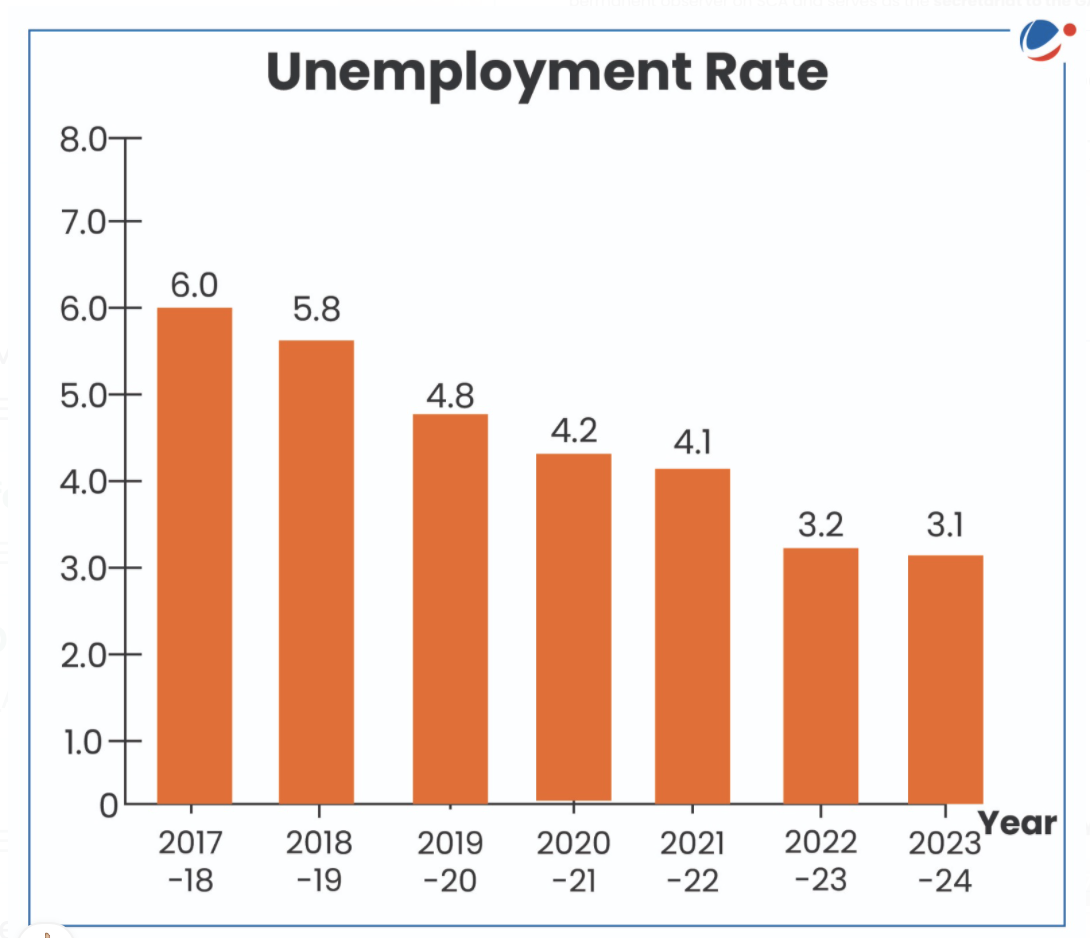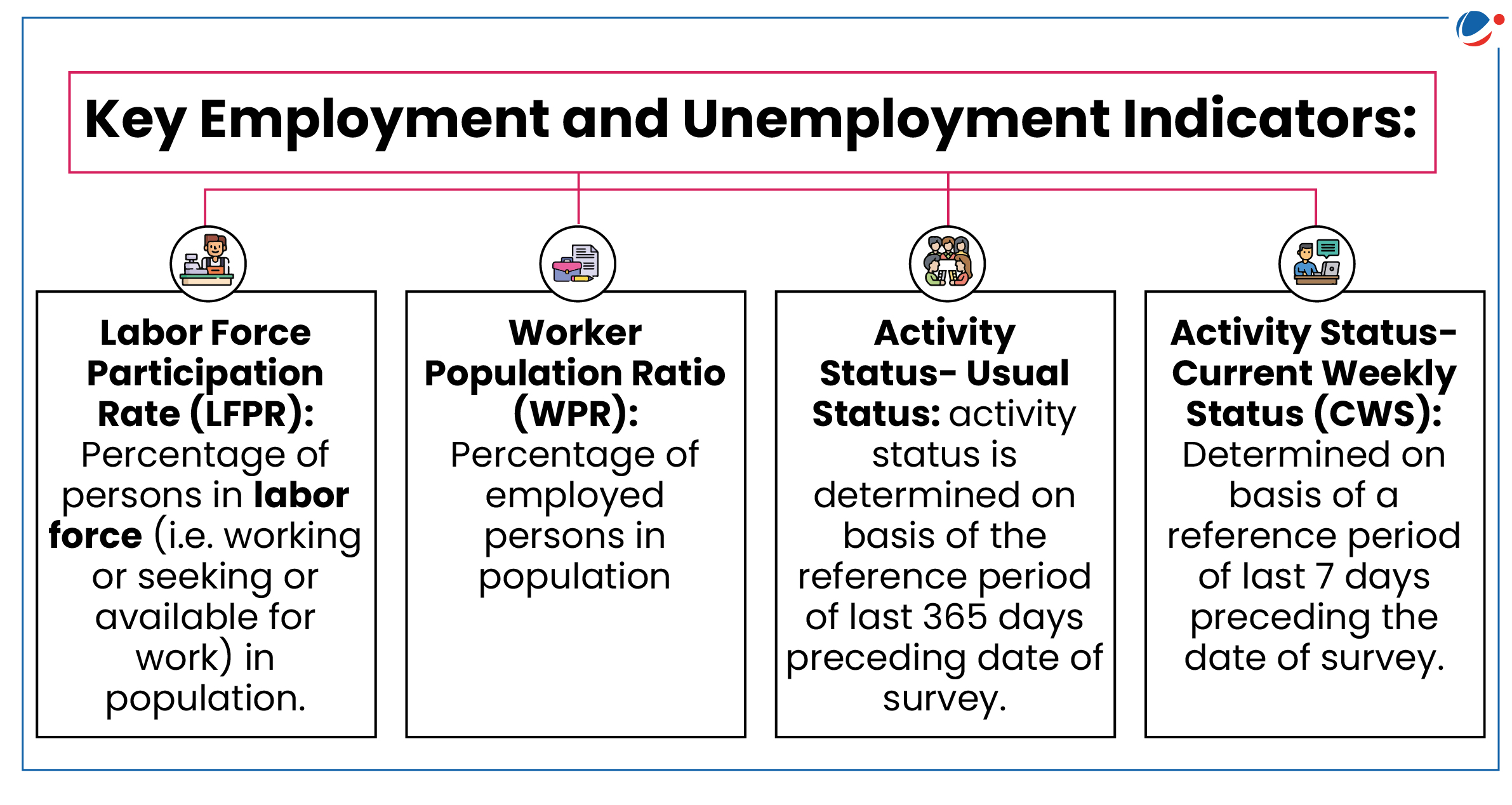Why in the news?
Recent data from Global IIT Alumni Support Group regarding campus placements at prominent IITs is prompting concerns about unemployment in India.
Status of Unemployment in India
- Centre for Monitoring Indian Economy: Unemployment rate saw an increase from 7.4 per cent in March 2024 to 8.1 per cent in April 2024.
- NSSO Data: According to Periodic Labor Force Survey (PLFS) for Calendar Year 2023 released by National Sample Survey Office (NSSO), unemployment rate was 3.1% for calendar year 2023 (in contrast to global unemployment rate of 5.1% in 2023).
- Urban unemployment rate (5.2%) for calendar year 2023 was higher than rural unemployment rate (2.4%).
- According to PLFS for Calendar Year 2023 women's labor force participation rate was 41%.
- World Bank Report: In the "South Asia Development Update Jobs for Resilience" report, highlighted below average employment ratios for women in India.
- International Labor Organization (ILO) report: The "India Employment Report 2024" revealed that one out of every three unemployed individuals was young.

Reasons behind Unemployment in India
- Higher population Growth: World Bank has warned that South Asia region including India was not making use of its demographic dividend.
- The World Bank report states that during the period between 2000-23, employment grew 1.7 per cent a year while working-age population expanded 1.9 per cent a year.
- Illiteracy: According to the ILO report, despite the considerable progress, the level of educational attainments at higher levels remains low and quality is a concern. This acts as a challenge to employment.
- Skill gap & Challenges in Skill Development: Only about 4.7% of Indian labor force has undergone any formal skill training.
- National Skill Development Corporation conducted a skill gap study between 2010 and 2014. Study found that 29.82 crore workers need to be skilled, reskilled, and up skilled.
- Expansion of skills training faces many challenges in India. These include low training capacity in poorer regions, low levels of socio-economic inclusion in training programs etc.
- Implementation of institutional measures suggested by the Sharada Prasad Committee on Skill India reforms.
- Impact of automation and technology on job market: Manufacturing is becoming more capital-intensive and automated, which provides growth but doesn't provide mass employment.
- By some estimates, it has been predicted that 69% of jobs in India are threatened by Automation.
- Seasonal nature of employment in certain industries: About 45.76% of the total workforce is engaged in agriculture (Seasonal employment) and allied sector during 2022-23.
- Casual and informal labor: Due to a scarcity of jobs, individuals often resort to informal sector employment, characterized by low and inconsistent wages.
- India's labor market is predominantly characterized by informal employment (approximately 90 per cent of adult and youth workers).

Steps Taken towards employment generation
- Aatmanirbhar Bharat Rojgar Yojana (ABRY): It has been launched as part of Atmanirbhar Bharat package 3.0 to incentivize employers for creation of new employment along with social security benefits.
- Pradhan Mantri Mudra Yojana (PMMY): Provides collateral free loans upto Rs. 10 lakh to micro/small business enterprises and individuals to enable them to setup or expand their business activities.
- Prime Minister Street Vendor's AtmaNirbhar Nidhi (PM SVANidhi Scheme): To facilitate collateral free working capital loan to street vendors to restart their businesses, which were adversely impacted during the Covid-19 pandemic.
- PM Vishwakarma Scheme: To provide end-to-end support to artisans and crafts people of rural and urban areas across the country. The Scheme aims to strengthen and nurture Guru-Shishya parampara.
- National Education Policy 2.0: It integrates vocational education into mainstream education and proposes that all students receive vocational education from Class 9 onwards. It aims to increase the employability of future generations by emphasizing skill development.
- Deen Dayal Antyodaya Yojana-National Rural Livelihoods Mission (DAY-NRLM): A scheme under the Ministry of Rural Development that organizes rural poor women into Self Help Groups.
- Pradhan Mantri Kaushal Vikas Yojana: Launched by Ministry of Skill Development and Entrepreneurship (MSDE) and implemented by National Skill Development Corporation (NSDC), this Skill Certification scheme enables the youth to take up industry relevant skill training.
- Others: Make in India, Start-up India, Stand-up India, Digital India, Smart City Mission, Rozgar Melas, etc.
Way Forward
- Make production and growth more employment intensive
- Boost productive non-farm employment, especially in manufacturing and emerging services sectors.
- Focus more on micro, small and medium-sized enterprises (MSMEs)
- Infrastructure investment (E.g. Store, Transport etc.) is required for increasing competitiveness of MSMEs Export.
- Increase agriculture productivity and promotion of entrepreneurship
- Labor and tax regulations can be streamlined to remove impediments to start-ups
- Adopting policies and measures to take advantage from new technologies.
- Improving quality of jobs
- Investing in and regulate emerging care (E.g. Childcare and care for elderly) and digital economies.
- Inclusive urban policy is required to address the needs of migrants, women and workers from poor households.
- Addressing issues related to Skill Training
- Imparting quality skill training and mainstream it into the education system to improve employability.
- Wide disparities in skills training across socio-economic groups & regions needs to be addressed.
- Imparting quality skill training and mainstream it into the education system to improve employability.
- Addressing of labor market inequalities
- Improving ICT access and bridge the digital divide.
- Increasing the flexibility of labor laws and regulations could boost employment, especially in formal sector.
- Restrictive minimum wages and employment protection laws have been associated with weaker employment in emerging markets economies.
- Increased Female labor force participation
- Monetary incentives such as wage subsidies or tax benefits.
- Closing gaps between the quality of boys' and girls' schooling.
- Broadening women's access to finance and other inputs.



